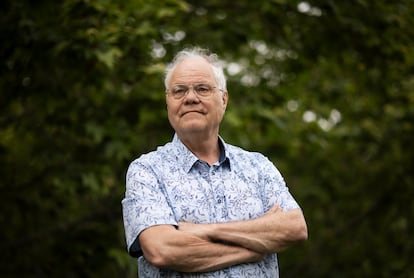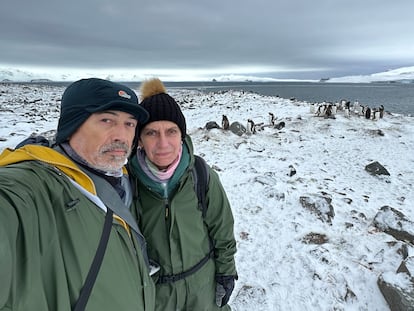Researcher Jean-Michel Claverie: ‘The next pandemic may come from a virus that emerged from permafrost’
The emeritus professor of genomics has managed to revive microorganisms that had been dormant for 48,500 years in the frozen soil of the Arctic

A decade ago, Jean-Michel Claverie, 73, thawed a gram of permafrost — permanently frozen soil in the Arctic — and managed to get a 30,000-year-old virus to revive and infect an amoeba. It was a milestone in a career in which he has recently found five new families of viruses, also called “zombie viruses,” in samples up to 48,500 years old taken from seven different places in Siberia. With climate change and temperatures rising in the Arctic faster than in the rest of the planet, the professor emeritus of genomics at Aix-Marseille University in France thinks that the time has come to stop considering these types of findings a scientific curiosity, and instead treat them as the “threat to public health that they pose.” This past Saturday Claverie shared his knowledge with 18,000 specialists who are gathered until Tuesday in Barcelona at the European Society of Clinical Microbiology and Infectious Diseases (ESCMID Global) Congress, the largest in the world of its kind.
Question. A pandemic caused by a virus that emerged from the ice. It’s scary, but it’s hard to believe, right?
Answer. Better to investigate, to know the risks and to take measures to minimize them. There are three key factors. One, there are viruses we don’t know about frozen in the permafrost. Two, rising temperatures are thawing more and more soil. And three, the number of people who move through these areas is growing.
Q. That means more chances of something happening, right?
A. Yes. And think about what happened to the populations of America when the Europeans arrived with their diseases. If humanity came into contact with an unknown pathogen it could be a demographic catastrophe.
Q. A pandemic like the coronavirus.
A. Much worse than that. The SARS-CoV-2 crisis was serious, but we already knew many things about coronaviruses. We have been researching them for decades and were able to respond very quickly with a vaccine. This shows us that even different forms of viruses that we already know can cause very serious pandemics. And these forms could have existed in the past and now be frozen. But if the virus were completely unknown, we would have to start from scratch. It would take several years to produce vaccines...
Q. Are you sure there are unknown viruses?
A. Yes, we have already found some.
Q. How?
A. We thawed a piece of permafrost and looked through the microscope. We looked at amoebas, which are single-celled beings that we can see well. Many times nothing happened, so there were no viruses in those samples. But other times we saw that the amoebas died, so there were surely some types of viruses in the samples that specialize in attacking them to replicate. We let them multiply and investigated them. We did it this way for safety.
Q. For safety?
A. Yes, because viruses are very specialized and if they infect amoebas, they do not attack other living beings. It’s not dangerous for us. Things would be different if we were handling frozen remains of human beings or species that were our ancestors.
Q. Okay, there are unknown viruses in the permafrost. But is it really a risk for them to thaw? Permafrost occupies one-fifth of the northern hemisphere. They are vast lands that are practically uninhabited. Every year their surface layer thaws and freezes again. And viruses probably won’t survive exposed to sun and heat.
A. In 2016 there was an anthrax outbreak in Siberia that affected a community of reindeer herders. Anthrax is caused by bacteria, but they produce spores that make you sick. And these spores, in essence, are not so different from viruses. They are inert particles that were reactivated after being frozen for hundreds or thousands of years. Viruses can also reactivate, they just have to find their host. And it doesn’t have to be human. The next pandemic may come from a virus that emerged from this frozen Arctic soil, permafrost.

Q. What do you mean the host doesn't have to be human?
A. Imagine that the permafrost virus reaches a river and infects a salmon. It has found its host. And it multiplies and extinguishes the salmon. The same can happen with cows. Or plants that are essential crops for humanity. A virus can cause a catastrophe without making humans sick.
Q. There are unknown viruses in the permafrost that can affect us. But they are still in uninhabited places.
A. Less and less so. Rising temperatures will make more and more land habitable in the north. And [mining] operations are constantly being opened there because they are territories very rich in hydrocarbons, metals, rare earths... We are drilling deeper and deeper, raising dust, removing large volumes of soil...
Q. What can be done to reduce risks?
A. If someone at these operations became seriously ill in Siberia, they would most likely be flown to Moscow. This is just what you should not do. It must be treated on site, and this means providing these facilities with competent medical equipment, spaces to isolate patients, means for quarantining, training workers... The most important thing is to make people aware that there is a risk, no matter how small. And to work with local populations.
Q. Why is that?
A. They will be the ones who in many cases notice that something odd is going on because they are the ones who move through the territory. They will be the ones who see changes in nature or different diseases. They must be trained and helped to raise the alert.
Q. I thought that the threat of climate change was the other way around, of diseases from the south going north.
A. That is the paradox. Specialists in these areas look to the south and study the mosquitoes that transmit malaria or dengue and whether they are colonizing new latitudes. That is a problem, but one that we already know. What we are not prepared for is the threat that can come from the north to the south. And this requires rethinking many things and organizations.
Q. Permafrost is in a small number of countries: Russia, the United States, Canada, nations in Scandinavia... Is it the same everywhere?
A. No. In northern America and Greenland the permafrost is rockier and has very little life. The interesting one for these investigations is the Yedoma type, rich in organic matter and which is in Siberia.
Q. You have a long international career. You have done research in Quebec, at the National Institutes of Health of the United States, at the Pasteur Institute... You are now in Marseille. How did you start this work?
A. By chance. I was researching the giant viruses that infect amoebas. Then I saw that a Russian team had managed to grow a plant from a seed that had been under the ice for 30,000 years. And I said to myself, why not do the same with these viruses?
Q. Has the political situation affected your research?
A. Yes, it has been a disaster. We cannot carry out joint research with Russian scientists or settle there. Fortunately, we have found a way to do this thanks to the Alfred Wagner Institute in Potsdam, Germany.
Q. How?
A. They collected samples from the so-called Batagaika crater in 2019, which date back to 650,000 years ago, which is more than 10 times what we had now. This surpasses carbon dating, which reaches 50,000 years, and forces us to use new techniques. We are preparing to work with these samples, but we have to be very careful to avoid contamination from current microorganisms. It is a scientific challenge.
Q. What was your latest discovery?
A. It is not yet published, but we have been able to find viruses at the bottom of the sea in Ross Sea, in Antarctica, right at the other end of the world. In this case it was thanks to a collaboration with Italian scientists who managed to remove some sediments from the seabed in Antarctica. They are, again, amoeba viruses, which attack these organisms to replicate, so we are finding out that this type of virus is absolutely everywhere.
Sign up for our weekly newsletter to get more English-language news coverage from EL PAÍS USA Edition
Tu suscripción se está usando en otro dispositivo
¿Quieres añadir otro usuario a tu suscripción?
Si continúas leyendo en este dispositivo, no se podrá leer en el otro.
FlechaTu suscripción se está usando en otro dispositivo y solo puedes acceder a EL PAÍS desde un dispositivo a la vez.
Si quieres compartir tu cuenta, cambia tu suscripción a la modalidad Premium, así podrás añadir otro usuario. Cada uno accederá con su propia cuenta de email, lo que os permitirá personalizar vuestra experiencia en EL PAÍS.
¿Tienes una suscripción de empresa? Accede aquí para contratar más cuentas.
En el caso de no saber quién está usando tu cuenta, te recomendamos cambiar tu contraseña aquí.
Si decides continuar compartiendo tu cuenta, este mensaje se mostrará en tu dispositivo y en el de la otra persona que está usando tu cuenta de forma indefinida, afectando a tu experiencia de lectura. Puedes consultar aquí los términos y condiciones de la suscripción digital.
More information
Archived In
Últimas noticias
Most viewed
- Sinaloa Cartel war is taking its toll on Los Chapitos
- Oona Chaplin: ‘I told James Cameron that I was living in a treehouse and starting a permaculture project with a friend’
- Reinhard Genzel, Nobel laureate in physics: ‘One-minute videos will never give you the truth’
- Why the price of coffee has skyrocketed: from Brazilian plantations to specialty coffee houses
- Silver prices are going crazy: This is what’s fueling the rally










































